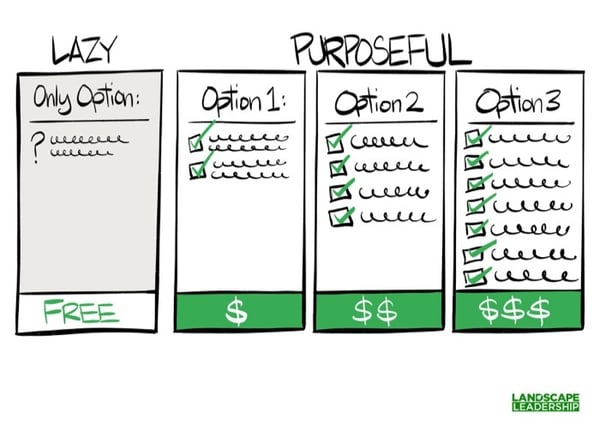How to Charge for Landscape Design to Win More Business and Make More Money
 Author: Chris Heiler
Author: Chris Heiler
If you missed the previous article about whether or not to charge landscape consultation fees, I recommend you go back and read it.
Here’s a response to that article from a subscriber:
"What a great article on consultation fees! We’ve been using this strategy for two years. Not only does it do everything you stated in the article, charging a fee has opened up hundreds of hours per year of new time to work on my company as opposed to meeting with potential clients that have absolutely no intention of buying our services. Our close ratio went from 40% to 80% almost instantly when we implemented this strategy." ~ Carson Browning, ITM Landscapes
I love getting feedback like this from readers. Keep your comments coming.
Now, let’s talk about charging a fee for your landscape design expertise.
Keep in mind, you’re in a unique position because of that expertise. It’s “creative” expertise. This is very different than expertise in a productized or commoditized service like lawn care, tree care, or commercial landscape maintenance (Read this article about creativity vs. production).
Creativity is valued. And because "value is subjective and entirely personal" (Enns, Pricing Creativity, 2018), you can get “creative” in how you charge for landscape design. More on that in a minute.
The traditional (lazy) approach to (not) charging for landscape design
There are many ways to offer your landscape design services to customers.
Frankly, most are lazy.
Many landscape companies gift free design as their foot-in-the-door offer, simply considering it a cost of doing business. Of course, customers view it exactly the same way and will treat it as such (hint: that of having minimal value).
This approach seems best for those of you who...
- Have limited design chops that make you indistinguishable from your competitors and/or...
- Design/build isn't your core service offering.
Then there are companies who charge a low, flat fee – say $500 – for a landscape plan.
This is the laziest approach of all.
Here’s what this says to your customer:
“We don’t actually value our expertise. We’re just charging you an arbitrary $500 because we’re really busy right now and we think this will either qualify or disqualify you from doing business with us.”
You’re selling design as a commodity, when instead you should be pricing it like a creative.
Another traditional (but better) approach
Most professional landscape designers and landscape architects will use a cost-based pricing model when selling their services, either charging design fees based on direct inputs (time x hourly rate) or a lump-sum fee based on an estimate of time.
I alternated between each when I owned my landscape design firm. I charged a lump-sum up front based on my estimated time and then charged for revisions on an hourly basis.
I found that charging for my design time on an hourly basis tended to be viewed as risky by clients because the fee could be seen as being open-ended.
This cost-based approach is preferred over the previous two mentioned because you actually capture your costs (and hopefully a profit) and put yourself in the enviable and valued expert position.
But it is still not the best approach.
Pricing for (maximum) profit
Let’s get back to what I said about pricing your landscape design fees in a creative way.
This will require that you follow two rules from here forward:
- You will price each client and their project uniquely by...
- Offering three options and prices to choose from.
In doing so you will eliminate the lazy and arbitrary flat rate $500 design approach and move beyond the cost-based approach of charging by the hour.
"Offering options" refers to bundling your design services into three unique scopes of work, ranging from the most basic offering (ex.- plan-view design) to one with the most value (ex.- plan-view design + 3D renderings + construction details).
Then you allow your client to choose what scope (i.e.- option) and cost they are most comfortable with.

This approach is effective for many reasons, starting with...
1. Offering options will instantly improve your closing rates
"One of the biggest pricing mistakes that creative professionals make is to put a proposal in front of the client that contains only one option. In such a take-it-or-leave-it proposition there are only two outcomes, 50% of which are positive and 50% of which are negative." (Enns, Pricing Creativity, 2018)
Improve your chances by offering three options instead of one. It's much more difficult for your client to walk away from three options than it is to slam the door on a single option.
With a take-it-or-leave-it approach you also risk scaring off the sensitive "price buyer". I've personally found myself in this position more than once. There's no reason for it. Presenting a lower cost option specifically for this price buyer will allow you to close a higher percentage of proposals (without giving away value and profit).
2. You will maximize profitability on each project
The opposite of a "price buyer" is a "value buyer", with whom perceived value is more important than cost.
When you offer free design – or a flat rate fee of let's say $500 – you only appeal to price shoppers, while ignoring value buyers. This common mistake is leaving substantial amounts of money on the table.
We can illustrate this with a client who has a stated budget of $100k to $150k for their landscaping project. You may propose a $1,000 flat rate fee for the design work while a competitor offers it for free. If this is a value buyer he or she is most likely willing to pay at least $5,000 for the landscape plans. Yet you settled for $1,000.
This is why you price each client differently and why you always include an option in your proposals specifically for the value buyer.
3. You will put your competitors at a distinct disadvantage
When I had my design firm I loved it when I would go up against companies offering their landscape design services for free. I had the advantage. Why? Because I was different – I would actually charge for landscape design.
With that in mind, now imagine presenting your client with a proposal that includes three options to work with you (compared to your competitor's freebie option).
By controlling the comparisons you marginalize your competitors proposals even more.
Read that last sentence again. It's the most important point in this article. We'll go more in depth on this point in the next article so make sure you are subscribed.
4. You will eliminate time spent on (perceived) low value deliverables
Not all of your clients expect or want to pay for color-rendered plans or 3D computer renderings. Some don't even want a detailed plant list.
Why waste time providing this? Landscape designers make this mistake of over-delivering time and time again. I did the same thing.
If done properly, bundling your landscape design services into three options ensures your client gets exactly what they want (and nothing more) and you get compensated for all value provided.
Wrap up
Along with charging a consultation fee for your expertise, this creative approach to pricing your landscape design services will make you a helluva lot more money.
And, frankly, this is exactly what you deserve as an expert in your profession. No more undervaluing your expertise and talent dammit!!
Making a fair profit is in your hands, not your clients. It requires a purposeful approach to everything you do, including pricing. I know you're not lazy, so stop pricing like it.
In the next article I'll dive deep into how to bundle and price your options (UPDATE: Here's Part Two of this series). Subscribe here if you're not already on our list. Or just add your email address to the form below.
Are you intrigued by this approach to pricing? This creative pricing strategy can be used for all of your services, not just landscape design fees. That should get your imagination running :) Schedule a meeting with us to learn how we help lawn and landscape companies develop and implement creative pricing strategies like this.




